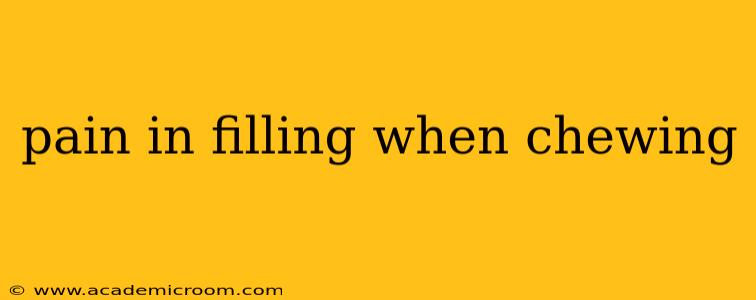Experiencing pain in a filling when chewing is a common dental issue that can range from a minor annoyance to a significant source of discomfort. Understanding the potential causes behind this pain is crucial for effective treatment and prevention. This comprehensive guide will explore the various reasons why your filling might be causing pain when you chew, offering insights into diagnosis, treatment options, and steps you can take to prevent future occurrences.
What Causes Pain in a Filling When Chewing?
Several factors can contribute to pain in a filling when chewing. Let's delve into the most common culprits:
-
High Filling: One of the most frequent causes is a filling that's been placed too high. This creates extra pressure on your tooth and the surrounding gum tissue whenever you bite down, leading to discomfort or even pain.
-
Fractured Tooth: Underlying tooth fractures, even microscopic ones, can be aggravated by the presence of a filling. The filling itself might not be the direct cause of pain, but rather a contributing factor that amplifies the existing discomfort.
-
Cracked Filling: Over time, fillings can crack or become dislodged, creating gaps that allow food particles, bacteria, and saliva to reach the sensitive dentin beneath. This can result in significant pain, especially during chewing.
-
Infection or Abscess: If bacteria manage to penetrate beneath the filling, it can lead to an infection or abscess. This infection can cause intense pain, swelling, and sensitivity to pressure, particularly when chewing.
-
Pulpitis (Inflammation of the Pulp): In severe cases, the infection might spread to the pulp (the soft tissue inside the tooth containing nerves and blood vessels). This inflammation, known as pulpitis, is characterized by throbbing pain that's often intensified by chewing.
-
Periodontal Disease: Gum disease can affect the supporting structures of your teeth, causing sensitivity and pain, particularly around fillings.
-
Sinus Issues: Sometimes, pain originating from sinuses can be mistakenly attributed to a dental filling. This is because the nerves in the upper teeth and sinuses are closely connected.
-
Bite Problems (Malocclusion): An improper bite can put excessive pressure on specific teeth and fillings, leading to pain during chewing.
How is Pain from a Filling Diagnosed?
Diagnosing the cause of pain related to a filling requires a thorough examination by a dentist. Your dentist will likely perform the following:
-
Visual Inspection: A visual examination of the filling and surrounding tooth structure to check for cracks, fractures, or high spots.
-
X-rays: X-rays help to identify underlying fractures in the tooth that might not be visible to the naked eye.
-
Bite Analysis: Assessment of your bite to determine if there are any malocclusions contributing to the pain.
-
Percussion Test: Gently tapping on the tooth to check for sensitivity.
-
Palpation: Gently feeling the area around the filling to detect any swelling or tenderness.
What are the Treatment Options?
Treatment for pain in a filling when chewing depends on the underlying cause:
-
Adjusting a High Filling: If the filling is too high, your dentist can easily adjust it by removing a small amount of the filling material to alleviate pressure.
-
Replacing a Cracked Filling: Cracked or damaged fillings need to be replaced to prevent further complications.
-
Root Canal Treatment: If an infection has reached the pulp, a root canal may be necessary to remove the infected tissue and save the tooth.
-
Extraction: In severe cases, if the tooth is beyond repair, extraction might be the only option.
-
Treatment for Periodontal Disease: If gum disease is contributing to the pain, periodontal treatment will be necessary to address the infection and inflammation.
-
Orthodontic Treatment: If malocclusion is the cause, orthodontic treatment may be recommended to correct the bite.
Can I Prevent Pain in Fillings?
Preventing pain associated with fillings involves practicing good oral hygiene and regular dental checkups. Here are some tips:
-
Maintain Excellent Oral Hygiene: Brush and floss regularly to remove plaque and food particles that can contribute to cavities and gum disease.
-
Regular Dental Checkups: Schedule regular checkups and cleanings with your dentist to detect and address any potential problems early.
-
Avoid Chewing on Hard Objects: Refrain from chewing on hard objects like ice, pens, or fingernails that can damage your teeth and fillings.
-
Protect Your Teeth from Trauma: Wear a mouthguard during sports or activities that could cause trauma to your teeth.
How Long Does Pain from a Filling Last?
The duration of pain from a filling varies depending on the cause and the treatment received. Minor adjustments to a high filling might resolve the pain immediately. On the other hand, a root canal or extraction might involve a longer recovery period.
Is Pain in a Filling a Dental Emergency?
While not always a dental emergency, severe pain, swelling, or fever associated with a filling warrants immediate attention. Contact your dentist as soon as possible if you experience these symptoms.
Remember, this information is for general knowledge and does not constitute medical advice. Always consult with a qualified dentist for diagnosis and treatment of any dental pain. Early intervention is key to preventing more serious complications and preserving your oral health.
